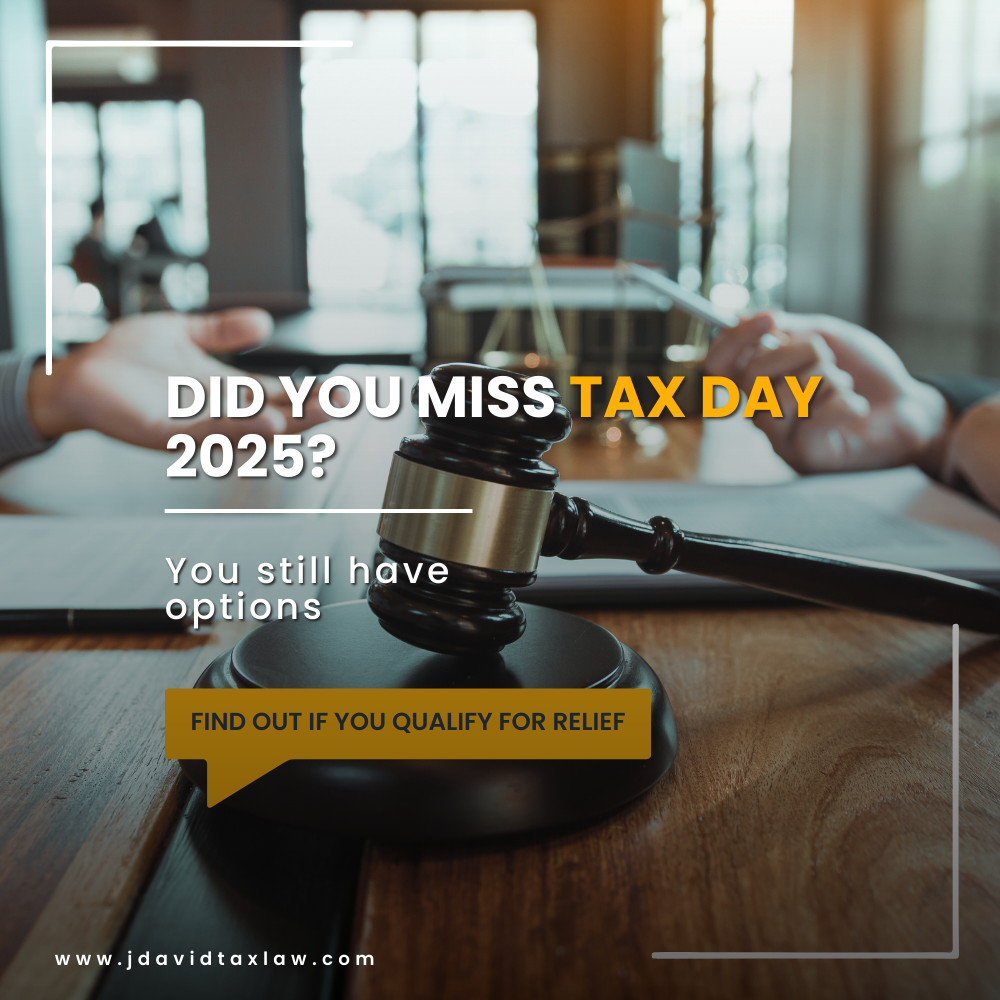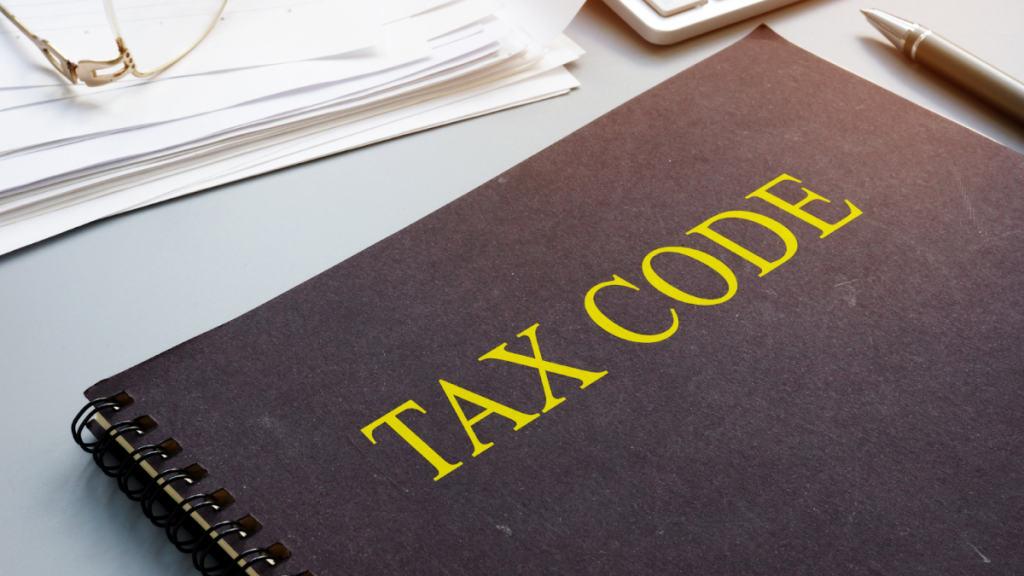Did You Miss Tax Day 2025? IRS Late Payment Rules & Relief Options
If you didn’t file your federal tax return or pay your taxes on time, you have options to get back on track. In this comprehensive guide, we’ll explain what happens after you miss Tax Day 2025, the IRS penalties and interest you might face, and all the IRS late payment relief programs available. We’ll cover payment plans, Offers in Compromise, Currently Not Collectible status, penalty abatement, and the risks of IRS enforcement (like liens, levies, garnishments, and even passport revocation). By the end, you’ll know exactly how to handle late taxes and how experienced tax attorneys can help resolve your IRS issues.
Immediate Consequences of Missing the April 15, 2025 Deadline
What happens right after Tax Day 2025 if you haven’t filed or paid? For most taxpayers, April 15, 2025 was the deadline to file your 2024 tax return and pay any tax due. Once that official tax return date passes, the IRS considers your return late if you haven’t filed, and any unpaid tax is immediately subject to penalties and interest. There’s no grace period penalties start accruing from April 16 if you owe taxes. If you requested an extension to file (giving you until October 15, 2025 to submit your return), remember that an extension to file is not an extension to pay. Any tax not paid by April 15 is now accruing interest and late-payment penalties, even if your return itself isn’t due until later.
IRS Failure-to-File and Failure-to-Pay Penalties
When you miss the tax deadline, the IRS can charge two main types of penalties: a Failure to File (FTF) penalty for not filing a return on time, and a Failure to Pay (FTP) penalty for not paying the tax you owe by the due date. These penalties are statutory and automatic, meaning they begin accruing without any special IRS action. Here’s how they work and how they’re calculated:
Failure-to-File Penalty
This is the harsher penalty. It accrues at 5% of your unpaid tax per month (or part of a month) that your return is late. It starts the day after the filing deadline (unless you filed an extension). The FTF penalty maxes out at 25% of the unpaid tax (reaching that cap after 5 months).
Failure-to-Pay Penalty
This penalty is smaller but can accrue for longer. It’s 0.5% of your unpaid tax per month (or part of a month) that the tax remains unpaid. It also begins right after the tax deadline and can continue up to a maximum of 25% of the tax (which would take 50 months to reach). If you filed on time or filed an extension but didn’t pay all your tax, you’ll only face this FTP penalty (and not the larger FTF penalty). Notably, if both the failure-to-file and failure-to-pay penalties apply in the same month, the 5% combined rate is reduced – the late-filing portion is 4.5% and the late-payment is 0.5% (total still 5% per month).
Interest on Unpaid Tax
In addition to the penalties, the IRS charges interest on the outstanding balance (your tax debt plus any penalties). Interest accrues daily from the due date (April 15, 2025) until the amount is paid in full. The interest rate can change quarterly; it is set at the federal short-term rate plus 3%. As of the second quarter of 2025, the interest rate for individual tax underpayments is 7% annually, compounded daily.
Penalty Abatement: How to Reduce or Remove IRS Penalties
By the time you address your late taxes, you might have already been hit with IRS penalties – failure-to-file, failure-to-pay, or others. These penalties can add up to thousands of dollars. The good news is, in certain cases the IRS can abate (waive or remove) penalties if you meet specific criteria. Seeking penalty relief can save you a lot of money, but you have to request it and qualify for it. There are a couple of primary avenues for penalty abatement:
First-Time Penalty Abatement (FTA)
The IRS has an administrative waiver called First-Time Penalty Abatement for taxpayers with a clean compliance history. If you have never been penalized (or at least not in the last 3 years prior) and you are otherwise compliant, the IRS may abate the penalties for one tax year no questions asked.
FTA most commonly applies to failure-to-file, failure-to-pay, or failure-to-deposit (payroll) penalties for a single tax period. For example, if 2025 is the first year you ever filed late and got hit with penalties, you could request first-time abatement for 2025’s penalties (once you file and pay/arrange payment). The IRS will remove those penalties, which can be a huge relief – but note they generally won’t remove the interest that accrued on those penalties. FTA is often granted immediately if you call the IRS and they verify your eligibility. It’s a one-time get-out-of-penalty-free card for otherwise compliant taxpayers.
Reasonable Cause Penalty Abatement
If you’re not eligible for FTA (or have already used it, or had penalties in multiple years), you can still request penalty abatement by showing reasonable cause for why you failed to file or pay on time. Reasonable cause means you had circumstances beyond your control or other good reasons for noncompliance – for instance, serious illness or hospitalization, a natural disaster, records destroyed by casualty, death or serious illness in the immediate family, reliance on incorrect advice from a tax professional, unavoidable absence, etc. The IRS will evaluate if your situation qualifies as reasonable cause under their guidelines.
Statutory and Other Relief
In some cases, specific penalty relief was granted by law (for example, the IRS provided automatic penalty relief for 2019 and 2020 late filings due to the pandemic, if filed by a certain date). Also, if the IRS made an error that caused you to be late or caused a penalty (not common, but it happens), they will abate those penalties. If you received incorrect written advice from the IRS, there’s a specific form (843) to request abatement based on that.
To request penalty abatement, you can call the IRS once your tax is paid or in an installment plan and specifically ask for first-time abatement or send a written request for reasonable cause relief. It often helps to have a tax professional make the case on your behalf, especially for reasonable cause, as they can cite the relevant IRS penalty handbook sections and present your case persuasively. Our tax lawyers know how to prepare compelling reasonable cause arguments and ensure you get any first-time abatement you’re entitled to. In many cases, we’ve been able to remove penalties entirely, saving clients money and helping them resolve their tax debts faster.
IRS Relief Programs
The IRS offers several relief programs designed to help individuals and businesses who are unable to pay their taxes in full. These programs aim to reduce financial strain by providing flexible payment options, temporary collection pauses, and in some cases, the ability to settle for less than the full amount owed. Understanding which option fits your situation is key to resolving tax debt effectively.
Pay your Tax Bill Over Time With IRS Payment Plans
One of the most common and straightforward relief options for late taxpayers is an IRS payment plan, formally known as an Installment Agreement. If you can’t pay your entire tax debt immediately, the IRS will usually allow you to make monthly payments toward your balance. Setting up a payment plan stops the IRS from taking more drastic collection actions as long as you make your payments on time, and it can significantly ease the financial burden by spreading it out. Here’s what to know about IRS payment plans:
Short-Term Payment Plan
If you can pay off your tax debt relatively quickly – within the next few months – you can request a short-term payment plan. The IRS defines short-term as 180 days or less (about 6 months). There is no setup fee for a short-term plan. Penalties and interest will still accrue until the balance is fully paid, but you won’t incur any additional fees for the plan itself. You can apply for this online if your total tax owed (including penalties and interest) is under $100,000. For many individuals or small businesses who owe a few thousand dollars, this is a great option – essentially an informal extension.
Long-Term Payment Plan
If you need more than 180 days, you’ll be setting up a long-term installment agreement with the IRS. This allows you to pay monthly over a longer period (up to several years, depending on the amount). To qualify for an individual long-term plan online, you usually need to owe $50,000 or less in combined tax, penalties, and interest, and have filed all required tax returns. (Owing more than $50k doesn’t disqualify you; it just means you can’t use the easy online system – you’d likely need to provide financial information and work out a plan directly with an agent.) A common streamlined installment plan is 72 months (6 years) to pay for balances under $50k, which the IRS will approve without requiring detailed financials in many cases.
Streamlined vs. Full Financial Disclosure
For balances above $50,000 (or if you need a payment term longer than the streamlined criteria allow), the IRS may require you to provide a Collection Information Statement (Form 433-F or 433-A) detailing your income, expenses, and assets, to determine an appropriate payment. If possible, try to get your balance under $50k (by making a partial payment) to qualify for streamlined processing – it’s less intrusive and faster. Under the IRS Fresh Start initiative, the threshold for streamlined agreements was raised to $50,000, making it easier for more taxpayers to get a payment plan without extensive financial scrutiny.
Business Payment Plans
Businesses (like C-corporations or sole proprietors with payroll tax debts) can also set up installment agreements. The thresholds differ (e.g., businesses must owe $25,000 or less to apply online in some cases).
Need help? Setting up an installment agreement is something you can do yourself, but if you have a complicated situation (like multiple years owed or borderline affordability), getting professional guidance can ensure you get the best possible terms. Our tax attorneys at J. David Tax Law regularly negotiate installment agreements on behalf of clients nationwide. Call us at (888) 342-9436 to book your free tax consultation.
Offer in Compromise (OIC)
What if paying the full amount you owe, even over time, is just not feasible? In some cases, the IRS will agree to settle your tax debt for less than the full amount through a program called an Offer in Compromise (OIC). An OIC is essentially the IRS’s version of a debt settlement you offer to pay a portion of your debt, and if the IRS agrees it’s the most they can reasonably expect from you, they forgive the rest. It’s an attractive option, but it’s also difficult to obtain because you must meet strict criteria.
To qualify, you must be current on all tax filings and payments. There are two main payment options (lump sum or periodic), and you must submit detailed financial disclosures with your application. The IRS does accept thousands of Offers in Compromise each year, but they reject many more. The process can take 6–12 months, and while many offers are rejected, a well-prepared submission, especially with help from experienced tax attorneys like those at J. David Tax Law, can double your chances of acceptance. Thinking about applying for an Offer in Compromise? Check out our in-depth guide here.
Currently Not Collectible Status
Another IRS relief option for those in a tough financial spot is called Currently Not Collectible (CNC) status. Sometimes referred to as “hardship status,” this is not a reduction of your debt, but rather a temporary suspension of IRS collection efforts. If the IRS agrees that you cannot afford to pay your tax debt at all and still meet necessary living expenses, they can classify your account as currently not collectible.
To qualify for CNC status, you must demonstrate genuine financial hardship,typically by showing that your income is only enough to cover essential living expenses, with nothing left over for tax payments. This usually involves submitting a Collection Information Statement (Form 433-F or similar), detailing your income, expenses, and assets. The IRS uses national and local standards to evaluate what expenses are considered necessary. If approved, the IRS will stop collection actions, though your debt remains and interest continues to accrue. CNC is often granted to individuals with low or fixed incomes, such as those who are unemployed, disabled, or reliant solely on Social Security, and who have little to no assets available to pay the debt.
What Happens If You Don’t Qualify for IRS Relief or Penalty Abatement
If your tax debt remains unresolved and you don’t qualify for IRS relief programs or penalty abatement, the situation can escalate quickly. The IRS has broad authority to enforce collection through a range of aggressive actions. It may begin by filing a federal tax lien, which is a public claim against your property and affects your ability to sell or refinance assets. If the debt continues to go unpaid, the IRS can issue levies that freeze your bank accounts, garnish wages directly from your paycheck, or seize physical assets like vehicles or real estate. Income sources such as Social Security and rental payments can also be partially seized, and in some cases, your passport can be revoked if your balance exceeds a certain threshold. These enforcement tools do not typically require a court order and can be implemented swiftly after notices are ignored. The longer the debt remains unresolved, the more these consequences become likely.
Conclusion
Missing the tax day deadline is serious, but IRS relief options exist to help you fix it. Whether it’s filing late, setting up a payment plan, settling for less, or getting penalties removed, you have pathways to get back in good standing. The IRS mainly wants taxpayers to come forward and work out a solution. By understanding the rules and acting promptly, you can mitigate the damage from filing or paying late. And if it ever feels like too much to handle alone, remember that professionals like J. David Tax Law is just a phone call away. With the right help, you can turn a missed Tax Day into a manageable payment plan or even a fresh start, putting your IRS troubles in the past.
Frequently Asked Questions
The last date to file your federal tax return for the 2024 tax year is April 15, 2025. If you request an extension by that date, you’ll have until October 15, 2025 to submit your return but any taxes owed are still due on April 15 to avoid penalties and interest. If you’ve missed the deadline, it’s important to take action quickly. Contact our tax lawyers to explore your options and avoid escalating IRS enforcement.














